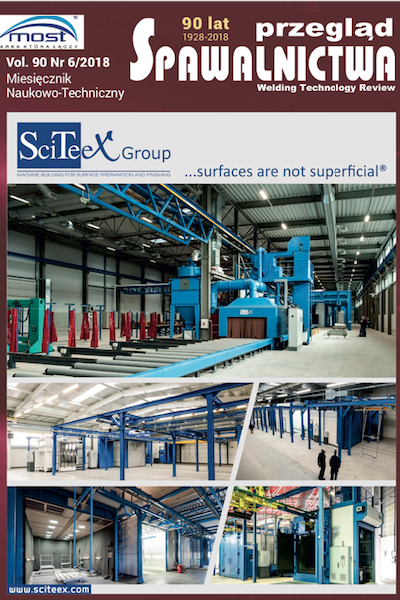Structure and mechanical properties of T91 welded joint with low-alloy root pass
Main Article Content
Abstract
The paper presents the results of metal science research of the T91 steel joint welded with two additional materials. The root pass was made with the additional material with its chemical composition similar to that of the 10H2M steel, and the fill pass was made with the material of the chemical composition of T/P91 steel. The examined joint was subject to heat treatment annealing 760 °C/2h. The non-destructive and the destructive tests proved that the investigated welded joint fulfilled the quality requirements at the B level and was characterised by the required or satisfactory me- chanical properties. The structural tests showed the occurrence of a single decarburised zone, its width and length be- ing of the order of several grains, between the root pass and the fill pass.
Downloads
Article Details
Creative Commons CC BY 4.0 https://creativecommons.org/licenses/by/4.0/
Welding Technology Review (WTR) articles are published open access under a CC BY licence (Creative Commons Attribution 4.0 International licence). The CC BY licence is the most open licence available and considered the industry 'gold standard' for open access; it is also preferred by many funders. This licence allows readers to copy and redistribute the material in any medium or format, and to alter, transform, or build upon the material, including for commercial use, providing the original author is credited.
References
Brózda J.: Stale żarowytrzymałe nowej generacji, ich spawalność i własności złączy spawanych. Cel stosowania stali żarowytrzymałych nowej generacji, ich charakterystyka i wynikające korzyści. Biuletyn Instytutu Spawalnictwa nr 1, s. 41-49, 2004.
Łomozik M., Hernas A., Zeman M.: Effect of welding thermal cycles on the structure and properties of simulated heat-affected zone areas in X10Cr- MoVNb9-1 (T91) steel at a state after 100,000 h of operation, Mater. Sc. Eng. 637A, pp. 82-88, 2015.
Łomozik M., Zeman M., Jachym R.: Cracking of welded joints made of steel X10CrMoVNb9-1 (T91) case study, Kovove Mater., (50), s. 285-294, 2012.
Brózda J.: Własności złączy ze stali P91 spawanych różnymi gatunkami spoiw, Biuletyn Instytutu Spawalnictwa nr 6, pp. 34-38, 2000.
Adamiec J.: Pękanie spawanych ścian szczelnych podczas eksploatacji, Przegląd Spawalnictwa, nr 4, s. 34-38, 2018.
Kudła K., Wojsyk K.: Ocena ilości ciepła wprowadzonego podczas procesów spawania łukowego, Biuletyn Instytutu Spawalnictwa nr 5, s. 121-127, 2010.
Kudła K., Wojsyk K.: Obliczeniowa energia liniowa, a ilość ciepła wprowadzonego podczas spawania, Przegląd Spawalnictwa nr 12, s. 21-25, 2010.
Kudła K., Wojsyk K.: Czy sposób doprowadzania ciepła ma wypływ na geometrię spoin?, Biuletyn Instytutu Spawalnictwa nr 5, s. 140-144, 2012.
Wojsyk K., Macherzyński M.: Określanie energii liniowej spawania metodą pomiaru pól poprzecznych spoin, Biuletyn Instytutu Spawalnictwa nr 5, s. 75-79, 2016.
Kudła K., Wojsyk K.: Possibilities of constructing safe and cort effective shields for -heat exchangers, Polish Journal of Environmental Studies. Vol. 22 (6A) pp. 26-29, 2013.
Michalczyk J., Wojsyk K.: Bezpieczne i ekonomiczne konstruowanie ekranów wymienników ciepła ze stali i innych stopów o ograniczonej spawalności, Przegląd Spawalnictwa nr 5, s. 37-42, 2014.
Sorentino S.: Welding technologies for ultra-supercritical power plant materials, Materials for Ultra-Supercritical and Advanced Ultra-Supercritical Power Plants, pp. 274-316, 2017.
Pawełczyk W., Wojsyk K.: Możliwości i ograniczenia spawania rurowych złączy różnoimiennych spoinami o odmiennej grani, Przegląd Spawalnictwa nr 4, s. 57-62, 2016.
High Temperature and Creep-resistant Filler Metals BÖHLER
PN-EN ISO 6507-1:2018-05: Metale Pomiar twardości sposobem Vickersa Część 1: Metoda badania.
PN-EN ISO 148-1:2017-02: Metale Próba udarności sposobem Charpyego Część 1: Metoda badania.
PN-EN ISO 5173:2010: Badania niszczące spoin w materiałach metalowych Badanie na zginanie.
PN-EN ISO 5817:2014 Spawanie Złącza spawane ze stali, niklu, tytanu i ich stopów (z wyjątkiem spawanych wiązką) Poziomy jakości według niezgodności spawalniczych
PN-EN 10216-2: Rury stalowe bez szwu do zastosowań ciśnieniowych Warunki techniczne dostawy - Część 2: Rury ze stali niestopowych i stopowych z określonymi własnościami w temperaturze podwyższonej.
